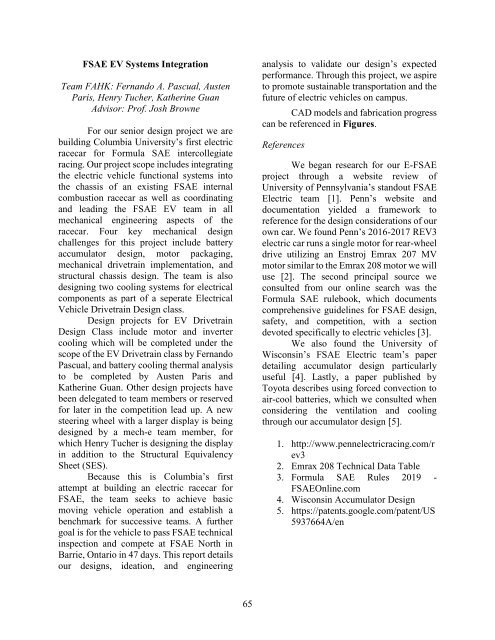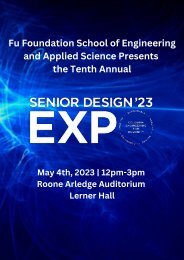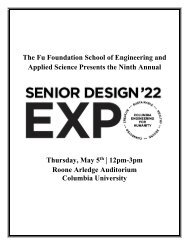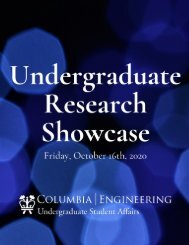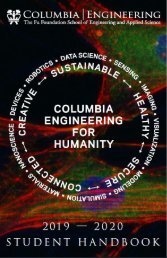Senior Design Expo 2019
The Senior Design Expo, held annually in May at Columbia University, is an opportunity for Columbia Engineering students to showcase what they have learned in their foundational math and science courses together with their engineering courses in innovative, creative, and purposeful designs and prototypes. Each year the Expo showcases more than 60 projects across all nine departments. Projects have included cutting-edge robotics, the New York City subway system, language technology, proposals for bridges to span the Hudson river, and much more.
The Senior Design Expo, held annually in May at Columbia University, is an opportunity for Columbia Engineering students to showcase what they have learned in their foundational math and science courses together with their engineering courses in innovative, creative, and purposeful designs and prototypes. Each year the Expo showcases more than 60 projects across all nine departments. Projects have included cutting-edge robotics, the New York City subway system, language technology, proposals for bridges to span the Hudson river, and much more.
Create successful ePaper yourself
Turn your PDF publications into a flip-book with our unique Google optimized e-Paper software.
FSAE EV Systems Integration<br />
Team FAHK: Fernando A. Pascual, Austen<br />
Paris, Henry Tucher, Katherine Guan<br />
Advisor: Prof. Josh Browne<br />
For our senior design project we are<br />
building Columbia University’s first electric<br />
racecar for Formula SAE intercollegiate<br />
racing. Our project scope includes integrating<br />
the electric vehicle functional systems into<br />
the chassis of an existing FSAE internal<br />
combustion racecar as well as coordinating<br />
and leading the FSAE EV team in all<br />
mechanical engineering aspects of the<br />
racecar. Four key mechanical design<br />
challenges for this project include battery<br />
accumulator design, motor packaging,<br />
mechanical drivetrain implementation, and<br />
structural chassis design. The team is also<br />
designing two cooling systems for electrical<br />
components as part of a seperate Electrical<br />
Vehicle Drivetrain <strong>Design</strong> class.<br />
<strong>Design</strong> projects for EV Drivetrain<br />
<strong>Design</strong> Class include motor and inverter<br />
cooling which will be completed under the<br />
scope of the EV Drivetrain class by Fernando<br />
Pascual, and battery cooling thermal analysis<br />
to be completed by Austen Paris and<br />
Katherine Guan. Other design projects have<br />
been delegated to team members or reserved<br />
for later in the competition lead up. A new<br />
steering wheel with a larger display is being<br />
designed by a mech-e team member, for<br />
which Henry Tucher is designing the display<br />
in addition to the Structural Equivalency<br />
Sheet (SES).<br />
Because this is Columbia’s first<br />
attempt at building an electric racecar for<br />
FSAE, the team seeks to achieve basic<br />
moving vehicle operation and establish a<br />
benchmark for successive teams. A further<br />
goal is for the vehicle to pass FSAE technical<br />
inspection and compete at FSAE North in<br />
Barrie, Ontario in 47 days. This report details<br />
our designs, ideation, and engineering<br />
analysis to validate our design’s expected<br />
performance. Through this project, we aspire<br />
to promote sustainable transportation and the<br />
future of electric vehicles on campus.<br />
CAD models and fabrication progress<br />
can be referenced in Figures.<br />
References<br />
We began research for our E-FSAE<br />
project through a website review of<br />
University of Pennsylvania’s standout FSAE<br />
Electric team [1]. Penn’s website and<br />
documentation yielded a framework to<br />
reference for the design considerations of our<br />
own car. We found Penn’s 2016-2017 REV3<br />
electric car runs a single motor for rear-wheel<br />
drive utilizing an Enstroj Emrax 207 MV<br />
motor similar to the Emrax 208 motor we will<br />
use [2]. The second principal source we<br />
consulted from our online search was the<br />
Formula SAE rulebook, which documents<br />
comprehensive guidelines for FSAE design,<br />
safety, and competition, with a section<br />
devoted specifically to electric vehicles [3].<br />
We also found the University of<br />
Wisconsin’s FSAE Electric team’s paper<br />
detailing accumulator design particularly<br />
useful [4]. Lastly, a paper published by<br />
Toyota describes using forced convection to<br />
air-cool batteries, which we consulted when<br />
considering the ventilation and cooling<br />
through our accumulator design [5].<br />
1. http://www.pennelectricracing.com/r<br />
ev3<br />
2. Emrax 208 Technical Data Table<br />
3. Formula SAE Rules <strong>2019</strong> -<br />
FSAEOnline.com<br />
4. Wisconsin Accumulator <strong>Design</strong><br />
5. https://patents.google.com/patent/US<br />
5937664A/en<br />
65


